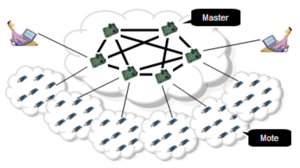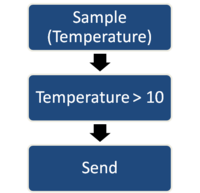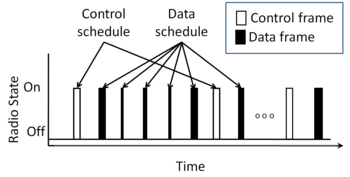Tenet: A Sensor Network Architecture
Introduction
|
Many sensor networks consist of two classes of nodes. Small
form-factor and resource constrained wireless sensor nodes are
deployed close to the phenomena being observed. Larger PC-class
devices form the processing and communication backbone for the
network. Tenet is a formalization of this two-tier architecture and
comes with a general-purpose software stack that has been used across
different types of sensor network applications.
|
 |
Programming Tenet
 |
A linear dataflow language is used to program the sensor nodes in
Tenet. A library of reusable and composable software modules is
provided covering a varity of tasks such as sensing, processing,
filtering, and thresholding the data. The language does not allow
nodes to aggregate data from multiple nodes. This means the nodes
perform simple in-node processing of data as specified by the data
flow program and send the data to the base station. All the
aggregation on data from across the nodes is done at the base
station. We have found that applications written in this centralized
architecture can be as efficient as distributed applications, even for
complex applications like track tracking.
|
Duty-Cycling Tenet
| Keeping the radio on when no communication is taking place can
be a major source of energy drain in a sensor node. Turning the radio
off during those idle times, or radio duty-cycling, can result in
large energy savings in sensor nodes and hence significantly longer
network lifetime. We designed Application Informed Energy Management
(AEM), a radio-dutycycling mechanism that exploits the properties of
Tenet and meets Tenet's requirements. Tenet's simple dataflow
programming language means we can easily analyze the application and
identify its data generation pattern. AEM statically analyzes and
infers the traffic profile for the application and accordingly tunes
the duty-cycling protocol. AEM uses elastic transmission and reception
schedules that allows it to adapt to dynamics while enabling bounded
latency of event detection. Our experiments show that AEM achieves
1-3% duty-cycles, while satisfying these three hard requirements:
dynamic multi-hop routing and tasking, multiple concurrent
applications, nad reliable end-to-end delivery.
|
 |
Publications
| Jeongyeup Paek, Ben Greenstein, Omprakash Gnawali, Ki-Young
Jang, August Joki, Marcos Vieira, John Hicks, Deborah Estrin, Ramesh
Govindan, and Eddie
Kohler, The
Tenet Architecture for Tiered Sensor Networks, ACM Transactions on
Sensor Networks (TOSN), Vol. 6, No. 4, 2010. |
|
| Omprakash Gnawali, Jongkeun Na, and Ramesh Govindan,
Application-Informed
Radio Duty-Cycling in a Re-Taskable Multi-User Sensing System,
In Proceedings of the ACM/IEEE International Conference on Information
Processing in Sensor Networks (IPSN 2009), San Francisco, CA, April
13-16, 2009. Acceptance Rate - 21/117 (17.9%) |
|
| Omprakash Gnawali, Ben Greenstein, Ki-Young Jang, August
Joki, Jeongyeup Paek, Marcos Vieira, Deborah Estrin, Ramesh Govindan,
and Eddie
Kohler, The
TENET Architecture for Tiered Sensor Networks, In Proceedings
of the ACM Conference on Embedded Networked Sensor Systems (SenSys
2006), Boulder, CO, October 31 - November 3, 2006. Acceptance Rate -
24/122 (19.7%) |
|
| Jeongyeup Paek, Omprakash Gnawali, Ki-Young Jang, Daniel
Nishimura, Ramesh Govindan, John Caffrey, Mazen Wahbeh, and Sami
Masri, A Programmable Wireless Sensing System
for Structural Monitoring, In Proceedings of the Fourth World
Conference on Structural Control and Monitoring (4WCSCM), San Diego,
CA, July 11-13, 2006. |
|


